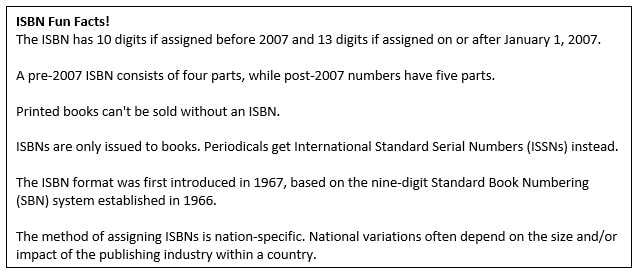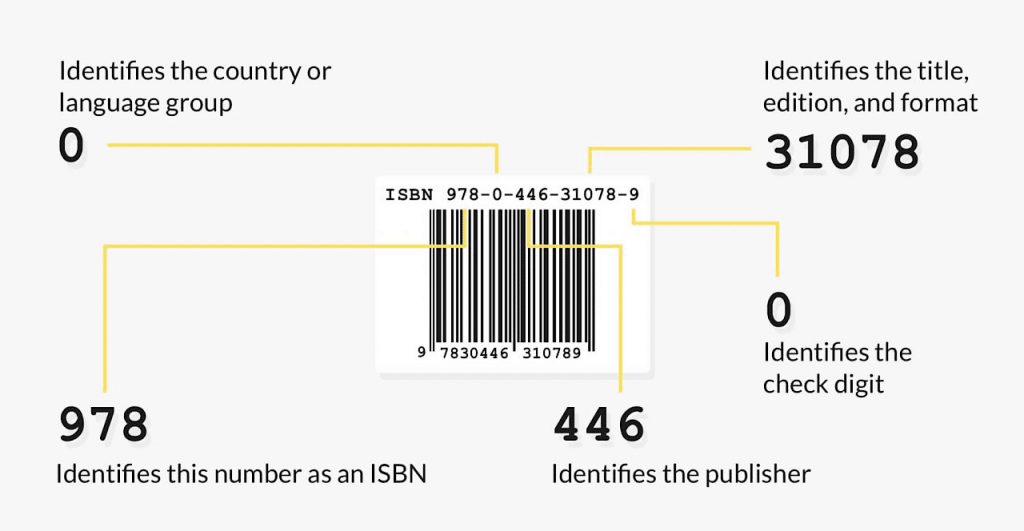ISBNs: The Alphabet Soup of the Literary World
June 10, 2020
Your grocery store cashier picks up your can of chicken noodle and waves it over a little sensor before delivering it to the conveyor for bagging. You know what’s happening: The can is stamped with a barcode that indicates the item and price. Once scanned, this information tells the cashier how much you owe and updates the store on its inventory.
But have you ever noticed a similar little barcode surreptitiously stamped on the cover of a book? That barcode is called an International Standard Book Number (ISBN).
What’s an ISBN?
An ISBN is a commercial book identifier. Each numeric code is a specific identifier that is recognized internationally. A unique number is assigned to each separate variation (except reprintings) of a publication to make it possible for readers to find the exact version they’re looking for. This means that the same book will have different ISBNs for its paperback edition, its hardcover printing, its e-book format, and even its audiobook version.
You even need to get a new ISBN if you publish an updated edition of the same book, as well as upon changing its title, switching to a different publisher, or having it translated.
In short, an ISBN designates a specific version of a specific book by a specific author. Even if your book goes out of print, the ISBN can’t be reused — because your book with that number still exists in some form.
The system was originally introduced to help retailers find and identify books way back in the pre-internet market. But it’s just as relevant today, thanks to the use of metadata in online searches. Your ISBN number carries important metadata about your book: title, author, price, and keywords that help readers find it.

Current ISBNs are displayed as a five-section barcode, and each section contains a very specific piece of identification:
- Prefix element: turns the number into a universal product identification code known as an EAN.
- Registration group element: refers to the country or geographical/language area of the book.
- Registrant element: identifies the publisher or imprint.
- Publication element: refers to the specific publication (title, format, edition).
- Check digit: acts as a redundancy for error detection.

Should I Get an ISBN?
The purpose of an ISBN is for sales.
If you plan to market your book to brick-and-mortar bookstores, online retailers, distributors, and libraries, you’ll need a number. Your book’s ISBN helps readers identify the correct publication; buyers order your book in the exact format they want; and suppliers track purchases and sales.
As the U.S. ISBN Agency explains, “An ISBN uniquely identifies your book and facilitates the sale of your book to bookstores (physical and digital) and libraries. Using ISBNs allows you to better manage your book’s metadata and ensure maximum discoverability of your book.”
Keep in mind, though, that this hard-and-fast rule only applies to hardcopy sales.
Many retailers — including giants like Amazon, Apple, and Barnes & Noble — do not require ISBNs for ebooks. And if your book will be more of a personal journey that you plan to print and distribute to a small group, there’s no reason to get an ISBN.
On the other hand, skipping the ISBN means your book will not appear in Bowker’s Books in Print, a comprehensive bibliographic database of book titles. And you might encounter some online retailers that won’t stock or sell your ebook.
The good news is that you can apply later if you change your distribution plans.
How Do I Get an ISBN?
The International ISBN Agency supervises the ISBN system worldwide, but each country has its own national agency. In the US, Bowker is the official agency that issues all ISBNs.
If your hardcopy book will be for sale in a traditional publishing scenario, your publisher will apply for a number for your book (in all its forms).
If you are self-publishing, you have two options. Your publishing service company can usually assign your book an ISBN at a negligible (or no) cost, in which case the publishing service is listed as the publisher of record. Or if you can apply on your own if you want to be considered the publisher of record.
Even though you’ll need to foot the bill if you apply for your own ISBN, rather than getting a publisher-assigned number, acquiring your own numbers grants you 100% control of the information in your book’s metadata. This includes the descriptions and categories that readers, libraries, and booksellers around the world search for to discover books and decide what to purchase.
Metadata has the potential to significantly boost the opportunity for your target readers to find your work — a must for self-published authors who do not have the marketing and distribution channels of the big guys.
Being recognized as the publisher of record also helps you establish a reputation and make a name for yourself in literary circles. If you intend to write multiple books, you’ll have a consistent publishing imprint on all your works. You’ll also be the contact for all orders and inquiries about your books.
Prices vary around the world (some countries even issue the numbers for free!) and depend on quantity. The more ISBNs you buy, the lower the per-number cost: In the United States, the current single-unit price is $125, while a 10-pack will set you back $575. If you have multiple versions of your book — or think you might, in the future, come out with different versions or revise and republish updated editions over the years – you will save some time and money by buying a block of numbers up-front.






























